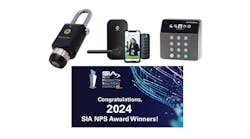I received a copy of "Locksmithing and Miscellaneous Shop Information", a one hundred-eighty page soft cover book. The copyright date is 1927, arranged and published by H. W. Routson. Printed onto the cover following the title is "The only Real Book on the Subject that has ever been Published."
At that time, mortise, rim and cylindrical locks were being manufactured, along with exit devices and door closers. Locksmiths worked with skeleton keys, flat steel keys, and cylindrical keys. The electric strike had been around for four decades. Yes, Virginia, locksmiths have been working with electricity for many years. Locksmithing was a mature profession; keyed different, keyed alike and master keyed locks provided all of the access control requirements. For special applications, locksmith would modify lock cylinders for specific applications including key traps or operate as one way cylinders.
Unauthorized persons were gaining access by loiding locks, wedging open doorframes and picking locks to name a few methods.
Zip ahead eighty-five years. Electronic access control and electromechanical locks have come a long way with more features yet to be introduced. Manufacturers are finding new ways of controlling access and to secure openings. Codes, rules and regulations are developing also, trying to cover the different aspects of security, and security versus life safety.
Today, even before an employee is terminated, their access code can be deleted. No longer permitting the employee into the facility. Even Frank Best would probably be amazed.
However, we are still attempting to find the "key" that works for gaining safe and secure access. As for the card, fob and biometric technologies, there are no permanent standards at this point in time. Only temporary solutions until the next method of "duplicating" becomes too public or easy.
To combat these problems if they affect our customers, we can provide an additional credential, add CCTV or human monitoring to the networked locks to confirm who according to the credential is attempting or gaining access.





